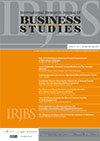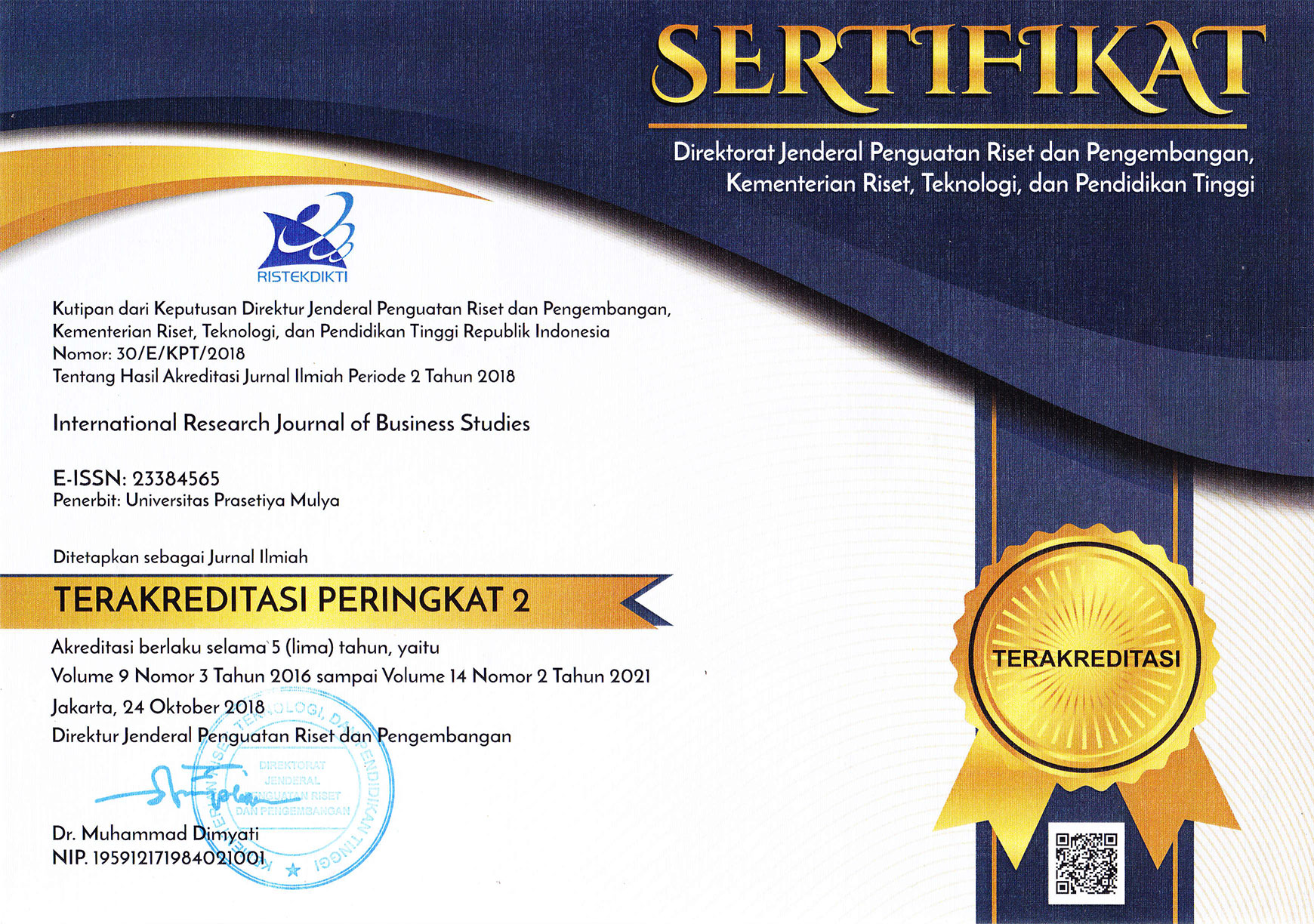The Effect of Leadership Style on Improving Employee Performance
DOI:
https://doi.org/10.21632/irjbs.16.3.229-240Keywords:
Leadership Style, Organizational Reputation, Corporate Reputation, Employee PerformanceAbstract
Leadership style significantly impacts the organization's long-term viability. On the other hand, leadership style can also affect an organization's reputation. This study intends to investigate the relationship between corporate reputation and leadership style, which has consequences for raising worker productivity. An online poll targeting employees in different work units and businesses in Indonesia was used to obtain the data. The study's findings can advance understanding, particularly in terms of the way that corporate reputation mediates the relationship between leadership style and employee performance. This research also has practical implications for management in an organization to be more aware of the role of organizational reputation that can influence employee performance. In addition, the quality of leaders is also one of the main drivers of organizational reputation, so a good reputation will create a climate of fair work competition for employees to improve their performance.
References
Aiken, L. S., West, S. G., & Reno, R. R. (1991). Multiple regression: Testing and interpreting interactions. sage.
Babalola, S. S. (2016). The effect of leadership style, job satisfaction and employee-supervisor relationship on job performance and organizational commitment. Journal of Applied Business Research, 32(3), 935–946. https://doi.org/10.19030/jabr.v32i3.9667
C Xie, RP Bagozzi, K. M. (2015). Marketing Intelligence & Planning Article information : Marketing Intelligence & Planning, 33(3), 238–257.
Chin, W. W., Chinn, W. W., & Chin, W. W. (1998). The partial least squares approach to structural equation modelling. In Marcoulides G. A. (Ed.). Modern Methods for Business Research, 295(2), 295–336.
Conte, F. (2018). Understanding the Influence of CEO Tenure and CEO Reputation on Corporate Reputation: An Exploratory Study in Italy. International Journal of Business and Management, 13(3), 54. https://doi.org/10.5539/ijbm.v13n3p54
Davari, A., & Rezazadeh, A. (2013). Structural equation modeling with PLS. Tehran: Jahad University. 215(January 2013), 2. https://doi.org/10.13140/2.1.3280.1922
Dowling, G. R. (2004). Journalists' Evaluation of Corporate Reputations. Corporate Reputation Review, 7(2), 196–205. https://doi.org/10.1057/palgrave.crr.1540220
Dwiedienawati, D., Tjahjana, D., Faisal, M., Gandasari, D., & Abdinagoro, S. B. (2021). Determinants of perceived effectiveness in crisis management and company reputation during the COVID-19 pandemic. Cogent Business and Management, 8(1). https://doi.org/10.1080/23311975.2021.1912523
Fackler, S., & Malmberg, L. E. (2016). Teachers' self-efficacy in 14 OECD countries: Teacher, student group, school and leadership effects. Teaching and Teacher Education, 56, 185–195. https://doi.org/10.1016/j.tate.2016.03.002
Fombrun, C. J., Gardberg, N. A., & Sever, J. M. (2000). The Reputation QuotientSM: A multi-stakeholder measure of corporate Reputation. Journal of Brand Management, 7(4), 241–255. https://doi.org/10.1057/bm.2000.10
Fombrun, C. J., & Riel, C. B. M. van. (2004). Fame and Fortune: How the World's Top Companies Develop Winning Reputations. 21–22.
Fornell, C., & Larcker, D. F. (2014). SEM with Unobservable Variables and Measurement Error. In Algebra and Statistics (Vol. 47, Issue 3, pp. 138-145.).
Frey, B. B. (2022). Statistical Power Analysis for the Behavioral Sciences. In The SAGE Encyclopedia of Research Design. https://doi.org/10.4135/9781071812082.n600
Goddard, J. T. (2003). Leadership in the (post)modern era1. Rethinking Educational Leadership: Challenging the Conventions, 11–26. https://doi.org/10.4135/9781446216811.n2
Hair, J. F., Ringle, C. M., & Sarstedt, M. (2011). PLS-SEM: Indeed a silver bullet. Journal of Marketing Theory and Practice, 19(2), 139–152. https://doi.org/10.2753/MTP1069-6679190202
Helm, S. (2005). Designing a Formative Measure for Corporate Reputation. Corporate Reputation Review, 8(2), 95–109. https://doi.org/10.1057/palgrave.crr.1540242
Henseler, J., Hubona, G., & Ray, P. A. (2016). Using PLS path modeling in new technology research: Updated guidelines. Industrial Management and Data Systems, 116(1), 2–20. https://doi.org/10.1108/IMDS-09-2015-0382
Hong, S. Y., & Yang, S. U. (2011). Public engagement in supportive communication behaviors toward an organization: Effects of relational satisfaction and organizational Reputation in public relations management. Journal of Public Relations Research, 23(2), 191–217. https://doi.org/10.1080/1062726X.2011.555646
House, R. J. (1971). A Path Goal Theory of Leader Effectiveness Author(s): Robert J. House Source. Administrative Science Quarterly, 16(3), 321–339.
Iqbal, S., Martins, J. M., Mata, M. N., Naz, S., Akhtar, S., & Abreu, A. (2021). Linking entrepreneurial orientation with innovation performance in smes; the role of organizational commitment and transformational leadership using smart pls-sem. Sustainability (Switzerland), 13(8), 1–18. https://doi.org/10.3390/su13084361
Ivancevich, J. M., Konopaske, R., & Matteson, M. T. (2014). Organizational Behavior & Management (10th ed.). McGraw-Hill.
Juliati, F. (2021). The Influence Of Organizational Culture, Work Ethos And Work Discipline On Employee Performance. AKADEMIK Jurnal Mahasiswa Ekonomi & Bisnis, 1(1), 34–39.
Kuncoro, I. (2021). Urgensi Leadership Dalam Manajemen Pendidikan Islam. Thawalib | Jurnal Kependidikan Islam, 2(1), 53–64. https://doi.org/10.54150/thawalib.v2i1.17
Kurniawan, H. (2022). Kepemimpinan Dalam Pendidikan Islam: Mengkritik Gaya Kepemimpinan Klasik Di Era Informasi. Proceedings of Internasional Conference on Islamic Studies, 1(1), 5. https://jurnal.ar-raniry.ac.id/index.php/icis/article/view/12668
Liu, W., & Gumah, B. (2020). Leadership style and self-efficacy: The influences of feedback. Journal of Psychology in Africa, 30(4), 289–294. https://doi.org/10.1080/14330237.2020.1777033
Men, L. R. (2012). CEO credibility, perceived organizational Reputation, and employee engagement. Public Relations Review, 38(1), 171–173. https://doi.org/10.1016/j.pubrev.2011.12.011
Men, L. R., & Stacks, D. W. (2013). The impact of leadership style and employee empowerment on perceived organizational Reputation. Journal of Communication Management, 17(2), 171–192. https://doi.org/10.1108/13632541311318765
Mulki, J. P., Caemmerer, B., & Heggde, G. S. (2015). Leadership style, salesperson's work effort and job performance: The influence of power distance. Journal of Personal Selling and Sales Management, 35(1), 3–22. https://doi.org/10.1080/08853134.2014.958157
Muslimah, I. R. (2021). Kepemimpinan Perempuan dalam Mengembangkan Budaya Organisasi. Jurnal Kependidikan Islam, 11(2), 198–207. https://doi.org/10.15642/jkpi.2021.11.2.198-207
Nashar, M., & Manurung, S. R. (2019). Pelatihan, Gaya Kepemimpinan, terhadap Reputasi Perusahaan dengan Kinerja Karyawan sebagai Variabel Intervening (Studi pada PT Astra Graphia,Tbk di Jakarta). INOBIS: Jurnal Inovasi Bisnis Dan Manajemen Indonesia, 2(2), 265–283. https://doi.org/10.31842/jurnal-inobis.v2i2.90
Olmedo-Cifuentes, I., & Martínez-León, I. M. (2014). Influence of management style on employee views of corporate Reputation. Application to audit firms. BRQ Business Research Quarterly, 17(4), 223–241. https://doi.org/10.1016/j.brq.2013.08.001
Ruth Silaen, N., Setyagustina, K., Kartika Ningsih, L., Puspita Sari, A., Bakti, R., Gede Satriawan, D., Min Fadlillah, A., Muftahah, A., Yusuf Alfian Rendra Anggoro, M. K., Idrus, S., Dewi Kartika, R., & Ristiani, R. (2021). Manajemen Sumber Daya Manusia. www.penerbitwidina.com
Shafie, B., Baghersalimi, S., & Barghi, V. (2013). The Relationship between Leadership Style and Employee Performance : Case Study of Real Estate Registration Organization of Tehran Province. Singaporean Journal of Business , Economics and Management Studies, 2(5), 21–29. https://doi.org/10.12816/0003885
Stacks, D. W., Dodd, M. D., & Men, L. R. (2011). Public Relations Research and Planning. August 2015.
StatSoft. (2006). The Electronic Statistics Textbook.
Sverke, M., Låstad, L., Hellgren, J., Richter, A., & Näswall, K. (2019). A meta-analysis of job insecurity and employee performance: testing temporal aspects, rating source, welfare regime, and union density as moderators. International Journal of Environmental Research and Public Health, 16(14). https://doi.org/10.3390/ijerph16142536
Downloads
Submitted
Published
How to Cite
Issue
Section
License
Copyright (c) 2024 Arif Ainun Na'im, Angga Febrian, Luthfi Firdaus, Risda Marvinita, Nova Mardiana

This work is licensed under a Creative Commons Attribution-ShareAlike 4.0 International License.
Journal Author(s) Rights
For IRJBS to publish and disseminate research articles, we need publishing rights (transferred from the author(s) to the publisher). This is determined by a publishing agreement between the Author(s) and IRJBS. This agreement deals with the transfer or license of the copyright of publishing to IRJBS, while Authors still retain significant rights to use and share their own published articles. IRJBS supports the need for authors to share, disseminate and maximize the impact of their research and these rights, in any databases.
As a journal Author, you have rights to many uses of your article, including use by your employing institute or company. These Author rights can be exercised without the need to obtain specific permission. Authors publishing in IRJBS journals have comprehensive rights to use their works for teaching and scholarly purposes without needing to seek permission, including:
- use for classroom teaching by Author or Author's institution and presentation at a meeting or conference and distributing copies to attendees;
- use for internal training by the author's company;
- distribution to colleagues for their research use;
- use in a subsequent compilation of the author's works;
- inclusion in a thesis or dissertation;
- reuse of portions or extracts from the article in other works (with full acknowledgment of the final article);
- preparation of derivative works (other than commercial purposes) (with full acknowledgment of the final article);
- voluntary posting on open websites operated by the author or the author’s institution for scholarly purposes,
(But it should follow the open access license of Creative Common CC-by-SA License).
Authors/Readers/Third Parties can copy and redistribute the material in any medium or format, as well as remix, transform, and build upon the material for any purpose, even commercially. Still, they must give appropriate credit (the name of the creator and attribution parties (authors' detail information), a copyright notice, an open access license notice, a disclaimer notice, and a link to the material), provide a link to the license, and indicate if changes were made (Publisher indicates the modification of the material (if any) and retain an indication of previous modifications.
Authors/Readers/Third Parties can read, print and download, redistribute or republish the article (e.g. display in a repository), translate the article, download for text and data mining purposes, reuse portions or extracts from the article in other works, sell or re-use for commercial purposes, remix, transform, or build upon the material, they must distribute their contributions under the same license as the original Creative Commons Attribution-ShareAlike (CC BY-SA).
This work is licensed under a Creative Commons Attribution-ShareAlike 4.0 International License.








